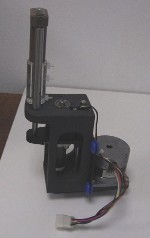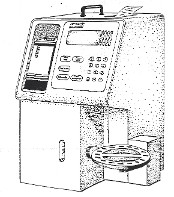History
The Begining
In the 1980s, AMDEV, Inc. grew successfully with our innovative ISE technology and products. We had a great direct sales force and the most wonderful and dedicated worldwide dealers for our classic LYTENING analyzer line. Requiring that our salespeople were current in our “competitor cove,” and did potent pioneering hands-on direct customer demos challenging any competitor, we were besting the ISE analyzer market leaders in the field everywhere. We also had a nice OEM customer early on in American Hospital Supply, later acquired by Baxter healthcare, for their Paramax analyzer.
In the mid-80s I carved out 2200 square feet to establish APEC with a new team expert and enthusiastic in another technology area, and the APEC Glucose analyzer was developed. In 1989 I sold AMDEV to Baxter Healthcare, influenced by family considerations and hope that some real money might work miracles, and moved APEC across the street.
|
|
|


|
APEC Glucose Inspires the Invention
This superior APEC glucose analyzer was to be based on the enzyme glucose oxidase, a classic enzyme technology. APEC developed an immobilized enzyme cartridge and wanted the analyzer to work with as little as 10 µL – very tiny at that time – so it could also be used for pediatric diagnostics with babies. But this required a very large dilution with a special reagent. All conventional technology at the time would have required that this be achieved by using a pair of syringe drives – one large syringe for the large volume of reagent and a small, 100 µL or better 50 µL, syringe to have the excursion stroke distance necessary for high precision and accuracy for such a small sample. My knowledge of the core technology at the time was limited to the searing insight that the fussy problems inherent to small syringes would drag the reliability of the whole system down, and I charged Humayun Qureshi, my brilliant VP of Engineering, with figuring out a way to meter small samples without needing a single small plunger or seal. For months, he continued to assure me that was impossible but I kept reaffirming my belief that he ought to be able to figure something out. Humayun finally had the needed epiphany and invented a pump with two pistons whose diameter difference provided the fine metering without any small piston or seal. The APEC Glucose sold for several years worldwide until the handheld glucometers, and the inclusion of serum glucose in the panels for large automated systems took over that market. The first DRD pump ever made was for the APEC Glucose, and a photo of it is seen at the left above the drawing of the analyzer for which it provided the fluidic heart. |
|
|
|
 |
Differential (Dual) Resolution Dilution (Displacement) – DRD and Pump Modules for the OEM Market
I named the core principles “Differential Displacement” and “Dual Resolution.” Although the ability to aspirate very small volumes very precisely and accurately were very obvious advantages, I remember Humayun once telling me, “Don, don’t ever forget the importance of the large piston mode for priming at the start as well.” Sanofi Diagnostics Pasteur of Chaska, Minnesota was developing a superior immunochemistry analyzer and found that our pump module was the only liquid-handling system that gave them the range of volume, flow, precision, and reliability they wanted in a single compact unit. They bought close to a couple of thousand DRD Pump Modules from us and then we licensed them. Humayun joined Sanofi in Chaska, Beckman later acquired Sanofi, and the Beckman Access immunochemistry analyzer used the DRD pump modules embodied in a nice plexiglass design (DRD “Plexi” pump). Johnson and Johnson and DPC Cirrus (later Siemens Medical) followed suit and various embodiments of our DRD modules become something of an immunochemistry analyzer standard. |
|
|
|
 |
Beyond the OEM pump Modules
We combined our core modules with a PC and a few accouterments to make Bench Top Diluters/Liquid Handlers. We developed the Robolab, a small completely self-contained single-channel desktop unit, with a friendly and interactive Roboprobe hand probe. We developed the Dual Resolution Syringe (DRS), able to substitute for a regular syringe and enormously expand its range and lower volume limit, including contact-free delivery of tiny samples. For automation, we developed TITAN, a splendid system. We designed TITAN to accommodate any of our core liquid-metering modules and pumps as well as syringe drives for the DRS, controlled by our Graphic User Interface GUI, operating at user choice through high level aspirate-dispense language down through core engineering and host source code. The GUI included our unique TEVIA factor control.
The Robolab and TITAN shared the same remarkable core capabilities, both able to do our “6 Favorites” by exercising the extremes of fine volume metering and high volume flow inherent to their shared unique core design. Those capabilities included precise and elegant placement and mixing of tiny materials in the tip, as seen in the photo at the left. One of the “6 Favorites” was to pick up the tiniest of samples with extreme precision and accuracy here and dispense it out cleanly right through the air there. Our VP of Operations Larry Harrison really liked the latter capability and called it “Little Squirt.” The name stuck and replaced the name Robolab. That particular latter function, it turned out, is “pipetting.”
|
|
|
|
 |
PipettorPlus
We, therefore, developed pipettors and applied our unique principles to the air-filled as well as liquid-filled worlds. We embodied the core principles differently to make the handheld PipettorPlus. NEPTUNE96 is our 96-channel, semi-automated pipettor. The “Pipettor” in PipettorPlus means that it works just like a regular pipettor, but the “Plus” means that it can also do things other pipettors cannot do and has additional advantages. The uniquely high flow and resolution range let it aspirate the tiniest samples with unsurpassed precision and accuracy, yet it has the flow power to deliver contact-free – immune to both contamination and wickoff errors. The sealing is better because we don’t need any small seal. Experience thus far is that most people find the contact-free delivery easier and faster because they don’t have to use as much hand and eye control (less “psycho-motor” stress). Short-sampling and other outliers do not seem to occur with our technology, partly because of the better sealing. Different people – with their individual hands and eyes – will get pipetting volumes that agree more closely, thus more accurate. The contact-free delivery also makes OEM incorporation into large systems easier because precise Z-axis control is not needed.
|
|
|
|
 |
Complete DRD Liquid-Handling Product Line
With the emphasis on air-filled systems, some of our excellent prior technology languished. But it all remains superior in its categories, so we have brought it all back up now and consolidated everything near where the Colonials generated so much in the early years. Our differential displacement /dual resolution pipettors now give us a complete line of liquid-handling products. The picture to the left shows a subassembly run of classic “Plexi” pump modules. Our products now fully span the end-user and the OEM liquid-handling worlds, both liquid-filled and air-filled, manual and automated. All share our unique and stunning DRD Differential Displacement / Dual Resolution core design principles. The DRD Pump, DRD Pipettor and DRD Syringe are all emboided via our VB control GUI in our automated TITAN and NEPTUNE96 systems, and also available OEM. |
|
|
|
|
I hope you enjoy the new website.
We look forward to hearing from you.
Donald Schwartz, M.D., President
|
 |
|
|
|
|